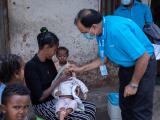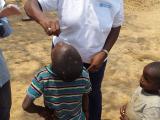Mar 7, 2013
CDC updates novel coronavirus guidance
The US Centers for Disease Control and Prevention (CDC) today updated its guidance on detecting novel coronavirus (NCoV) infections, based on the latest developments. Yesterday the World Health Organization (WHO) confirmed another infection from Saudi Arabia, pushing the global number of cases to 14, including 8 deaths. So far no cases have been detected in the United States. However, the CDC said in Morbidity and Mortality Weekly Report (MMWR) today that details surrounding a recent case cluster in England prompted the agency to update its guidance for US clinicians. It said the cluster shows the first clear evidence of human-to-human spread, involved a co-infection (with influenza A), and revealed that some patients can have mild disease. Patients who get sick with a severe lower respiratory illness within 10 days of traveling to the Arabian Peninsula or surrounding countries should continue to be evaluated, and those whose illnesses are unexplained or meet other investigation criteria should be reported to the CDC through local or state health departments, the guidance says. Patients meeting similar criteria who aren't responding to known infections should also be considered for NCoV infection, the CDC said. Those who have severe infections and are close contacts of sick travelers who have a recent history of visiting Arabian Peninsula region countries should also be evaluated for the new disease. The agency urged clinicians to check its coronavirus Web site for potentially frequent guidance updates.
Mar 7 MMWR report
Mar 7 CDC updated novel coronavirus guidance
Lab capacity assessment shows shortages in several areas
Local, state, and national public health agencies need to collaborate and improve in a number of areas, particularly those related to the human-animal interface, to achieve optimal testing and response capacity, and workers need better access to training and educational opportunities, an MMWR report today concluded. The report summarizes the 2011 National Laboratory Capacity Assessment, which assessed lab workforce, capacity to carry out functions in 19 program areas, and worker recruitment, retention, and retirement plans. A Web-based questionnaire was sent to 105 public health, environmental, and agricultural laboratory directors from July through August of 2011, with follow-up to maximize response. Eighty labs representing 6,656 employees (5,555 [83%] of whom were laboratorians) responded to the questionnaire. Among the gaps identified were capacity in agricultural microbiology and agricultural chemistry, as well as in toxicology and worker recruitment. A CDC editorial note pointed out that the low capacity in agriculture-related services is of special concern given the importance of the human-animal interface in the risk for emerging disease threats. It also comments that the lack of capacity in toxicology is notable because of increasing environmental pollution and the possibility of unintentional or intentional chemical releases.
Mar 8 MMWR report
Polio worker attacked in remote Pakistan area
Armed militants accosted and tortured a polio worker in Landikotal, Pakistan, yesterday and threatened further action if the man and his coworkers didn't shut down the campaign, the Pak Tribune, an online newspaper based in Rawalpindi, reported today. Lakdikotal is a town in the Federally Administered Tribal Area of Pakistan near the border with Afghanistan. The worker told authorities the team wouldn't continue the vaccine campaign without extra security. A town official said more security would be provided to vaccination teams and that authorities are searching for the attackers. The incident is the latest in a string of attacks against polio workers in Pakistan. Some Pakistani militants see the vaccination campaigns as Western-backed plots to gain intelligence in sensitive areas, and others have used the attacks as retaliation against drone strikes.
Mar 7 Tribune story


















